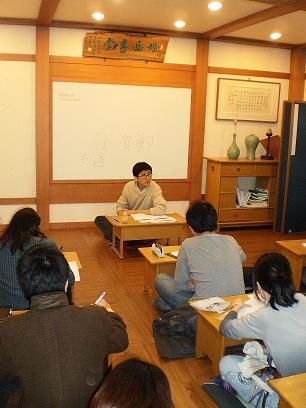Muak Seodang

Information
Location: Widang Hall Room 508
Lecture Hours: Every Thursday from 6:30 p.m. to 8:30 p.m. in 2010 spring semester
Classes Held: Usually one class is held during a single semester and in vacations.
The course covers the original versions of Oriental Classics written in Chinese characters, such as the Analects of Confucius (Ron-uh), the Chronicles of the Three States (SamGook SaGi).
Tuition Fee: ₩30,000 for 12 weeks
Register via e-mail (jinjin1981@empas.com) (T.A.)
What is the charm of chinese characters?
Masterpieces of Oriental Classical literature are covered in Muak Seodang. Currently, we are studying Chronicles of the Three States (SamGookSaGi in Korean). The lecture is done through reading the text and interpreting it. Mastering traditional Chinese characters is like knowing Latin in Western literature: You can open a secret treasury or archive of literature from ancient times to the Middle Ages. Such magic-like features of Chinese characters appeal to students, letting them become immersed in Oriental Classics naturally. Instead of blindly believing the records from the text, it is reinterpreted from a modern perspective and students do a critical reading through discussions.
Suh Hyun-kyoung, PhD
A student taking Chronicles of the Three States says, "It is very exciting to study with an original text in the form of old copy. Calligraphy is written vertically inside vertical lines produced with a brush." Meanwhile, Jang Jin-yeop (Teaching Assistant, Muak Seodang) adds, "The program needs to be funded more. The budget for humanities-related departments has been reduced and so has that for Muak Seodang. I think there should be more active advertisement. If more Yonseians get to know the existence of this place, many would be able to enjoy this program and feel genuine interest in Oriental Classics. Also, there is only one class held every semester, so I hope more courses are taught."
*Seodang: A traditional village school of Korea where children received primary education.

